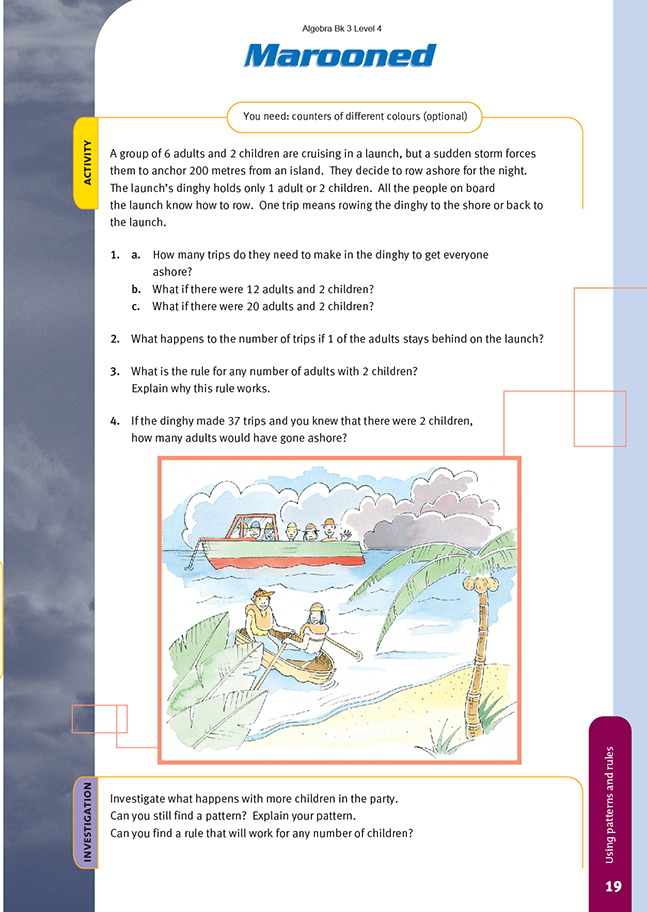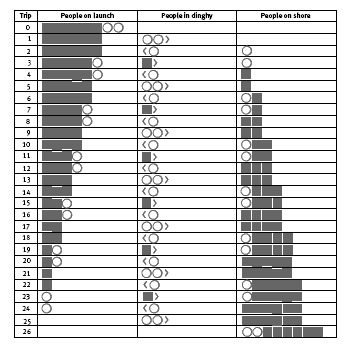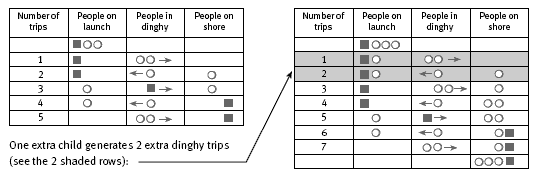This is a level 4 algebra strand activity from the Figure It Out series.
A PDF of the student activity is included.
Click on the image to enlarge it. Click again to close. Download PDF (191 KB)
write a rule for a relationship
FIO, Level 4, Algebra, Book Three, Marooned, page 18
counters of different colours (optional)
In this activity, the students should use counters to represent the adults and children involved in the transfer by dinghy between the launch and shore. Give them the problem and let them spend time in groups to see if they can find a way forward. A systematic approach to the problem is outlined in the table on the next
page, with the circles () representing children and the squares (
) representing adults.
This can be summarised in a table, showing that each additional adult adds another 4 trips:
So a rule is: the number of trips is equal to the number of adults multiplied by 4, plus 1. If there are x adults and 2 children, the number of trips, y, can be expressed as y = 4 x x + 1 or y = 4x + 1. So, for 20 adults, there are 4 x 20 + 1 = 81 dinghy trips, and for 100 adults, there are 4 x 100 + 1 = 401 dinghy trips. (The students will probably realise that in this scenario, the children do a lot of rowing!)
In question 4, there are 37 trips altogether. Students who know their multiplication facts for 4 will quickly see that 4 x 9 + 1 = 37. So 9 adults are involved.
Investigation
Many students, including able students, will find the investigation challenging. The tables below show what happens when there is 1 adult and the number of children increases from 2 to 3.
The following table shows the number of trips generated by different numbers of children. (We are not concerned here with the number of adults involved.)
Note how the number of trips increases by 2 for each additional child after 2 children. There must always be at least 2 children. The rule linking the number of trips with the number of children is: the number of trips = 2 x the number of children – 3. This rule is based on the pattern shown in the table above.
Answers to Activity
1. a. 25 trips. (Using the rule given for question 3, the short cut is 4 x 6 + 1 = 25.)
b. 49 trips would be needed (4 x 12 + 1).
c. 81 trips would be needed (4 x 20 + 1).
2. 4 fewer trips are required because each extra adult generates 4 trips.
3. A rule for any number of adults and 2 children is:
4 times the number of adults, plus 1. It takes 4 trips to get 1 adult across, plus a final trip for the 2 children.
4. 9 adults (4 x 9 + 1 = 37), which in reverse is (37 – 1) ÷ 4 = 9.
Investigation
Answers will vary. 2 extra trips are needed for each child after the first 2 children (to get them to the shore at the end). For any number of adults and 3 children,
the rule is: 4 times the number of adults, plus 3. The rule for any number of adults and any number of children is: 4 times the number of adults, plus twice the number
of children, minus 3.


